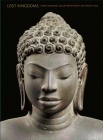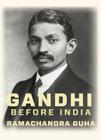Gandhi Before India
The first volume of what may well be the definitive biography of Mohandas Gandhi, Ramachandra Guha's Gandhi Before India covers the years from Gandhi's birth in 1869 through his departure from South Africa in July, 1914.
Biographers have often treated Gandhi's earlier life-- especially his two decades working in South Africa--as a little more than a warm-up for leading the struggle for Indian independence. Guha gives this period serious and detailed attention, arguing that such attention is necessary if we are to understand both "how the Mahatma was made" and Gandhi's critical role in South African history.
Even a reader who is familiar with Gandhi's history will find new insights in Gandhi Before India. Guha not only draws on Gandhi's own writings from and about this period, but also uses a wide range of contemporary sources, from Gandhi's childhood school reports to secret files kept by South African officials. By focusing on contemporary records rather than retrospective accounts, he overturns some accepted "truths" and introduces new elements to a familiar story. Perhaps the most interesting parts of the book are the side excursions that illuminate elements of Gandhi's life: the British ranking Indian rulers, the history of vegetarianism in England, Johannesburg as a cultural and intellectual melting pot.
Gandhi Before India is a step-by-step account of how a previously uninspiring member of a Gujurati merchant caste transcended the conventions of his caste, class, religious and ethnic backgrounds to become one of the most important--and controversial--figures of the twentieth century. I recommend it highly.
A version of this review appeared previously in Shelf Awareness for Readers.
History on Display: Lost Kingdoms

In the first millennium, a series of kingdoms that most of us have never heard of grew up in Southeast Asia : Pyu, Funan, Zhenla, Champa, Dvaravati, Kedah, and Srivijaya. Their boundaries roughly reflect the political map of the region today. Over time, their rulers adopted Hinduism and/or Buddhism as their official religions. In 1968, George Coedès described this official adoption of the religions of the Indian subcontinent in his seminal work The Indianized States of South East Asia. He argued that Indian states colonized Southeast Asia. More recent scholarship suggested that the process of Indianization was less thorough than Coedès believed* and that it was a result of acculturation rather than colonization. The exhibit was billed as using "sculpture as a lens to explore this period of Southeast Asian history." I had read Coedès as an undergraduate and had followed the developing academic argument in a low-key way over the years. I was jazzed about the exhibit, to say the least.
Lost Kingdoms was both artistically breath-taking and historically disappointing. The artifacts on display, many of them loaned by the governments of Cambodia, Vietnam, Thailand, Malaysia, Singapore, and Myanmar and never before seen outside their countries, are fabulous and beautifully displayed. But as is so often the case in art museums, the curators focused on describing the exhibits as objects without providing much context. I wanted more information on long-distance trade routes within the Indian Ocean World, Buddhist merchants, and the use of Vishnu as the model of kingship. I wanted to asked my fellow viewers whether they knew enough about Buddhism, Vishnu, Shiva, Durga, rakshas,** and nagas for the signs to mean anything. The conversations I overheard suggested that most of them were concentrating on whether a particular piece came from Vietnam or Cambodia.
In all fairness, I did not rent an audio tour--possibly it was full of historical goodies. More importantly, the accompanying catalog, written by John Guy, is beautiful, well-written and thoughtful.***
My recommendation? If you're in New York, take the time to see the exhibit but moderate your historical expectations. If you're actively interested in the "lost kingdoms" of early Southeast Asia, track down the book.
*First guy in the field gets a pass for being overly enthusiastic.
**No, not rickshaws, Autocorrect. Though my guess is that most everyone in the hushed gallery, including me, knew more about rickshaws than anything they were looking at.
***I almost gave in to the temptation to buy it. After all, I'd promised not to go the The Strand, not to return home bookless. I resisted, but once I'm in the new office with the additional bookshelves.....
Traveling the Silk Roads
We tend to use the phrase "the Silk Road" as if it were the Route 66 of East-West commerce. In fact, it is a metaphor. German geographer Ferdinand Freiherr von Richthofen (1833-1905) invented the name in the late nineteenth century, long after the overland luxury routes between Asia and the West had been supplanted by the sea trade. Instead of a single "Silk Road", trade between China and the West traveled over a network of hazardous routes that led from China across Central Asia and then over the Iranian plateau to Baghdad and Damascus, or through the Syrian desert to the Mediterranean. The routes shifted as empires and markets rose and fell or stretches were rendered unsafe by armed nomads, bandits, war, disease, or tax collectors.
The Chinese had produced silk for several thousand years and traded with Central Asia for about a century when Rome discovered silk and what we think of as the Silk Road began. Rome first encountered silk in 53 BC in a battle with the Parthians outside of Carrhae. According to Plutarch, the Romans were blinded when the Parthians unfurled their embroidered banners, "shining with gold and silk." Within sixty years of the defeat at Carrhae, the Roman Senate passed sumptuary laws forbidding men to wear silk. Roman critics grumbled about the effects of silk on Rome's morals--and its trade balance. Romans paid for unwoven Chinese silk in gold, weight for weight; Pliny the Elder estimated that Rome lost 45 million sesterces a year to the silk trade. (To put this in context, a loaf of bread cost about half a sesterce. Forty-five million is a lot of sandwiches.)
Goods traveled all the way from Asia to Europe and from Europe to Asia; traders did not. First the Parthians, then the Sassanians and finally the Islamic kingdoms of Central Asia, blocked direct trade between China and the West--something that both the Chinese and the Romans complained about bitterly. The wealth of the silk trade created thriving cities and prosperous kingdoms throughout Central Asia. Well aware of the importance of the merchant caravans, Central Asian rulers built networks of caravansaries along the roads that linked the major cities: fortified inns that offered secure accommodations for merchant caravans that might include as many as 1,000 camels.
In the thirteenth century, the major routes of the East-West trade came under the control of the Mongols. Markets and producers that had been separated by hostile powers since the fall of Alexander the Great's short-lived empire were once again linked under a single government. The Mongols boasted that a young woman could walk from one end of the empire to the other carrying a pot of gold on her head without being molested.* For the first time, merchants like Marco Polo were able to travel the entire length of the trading routes from Europe to China and back, though not many did.
The death of the Mongol ruler Timur** in 1405 was the beginning of the end of the Silk Roads. His successors were not able to hold together the vast Mongol empire. The Khanates disintegrated into a handful of warring Central Asian states, unable to control or protect the East-West trade.
China, too, was in a period of upheaval. The death of the last Mongol ruler of China is 1386 was followed by the rise of an ethnically Chinese ruling dynasty for the first time in centuries. The Ming rulers wanted to cleanse China of the corruption of foreign rule and restore traditional Chinese values.*** In 1426, the Ming Emperor Yongle closed China's borders to the northwest.
China's borders were closed, but caravans continued to travel west for another hundred years. The Silk Roads met their end when European discoveries in navigation and shipbuilding opened up the sea route to India. The sea route was faster and less expensive. The caravans that traveled the Silk Roads were no longer needed to bring silk and spices from the East to the markets of Europe. Slowly the Silk Roads withered until only the romance remained.
* I have my doubts.
**You may know him as Tamurlane, the Anglicized version of a jeering nickname given him by his enemies-- Timur-i-lang, Timur the Lame.
*** [political rant redacted]
